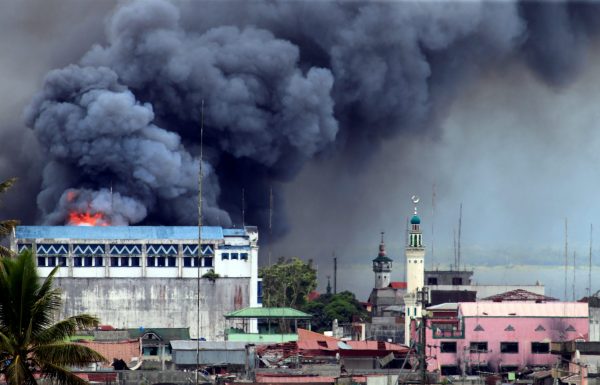It has been more than 60 days since the outbreak of violence in the Islamic city of Marawi on the morning of 23 May. Over 314,000 persons are displaced. More than half of the lakeside city is in ruins and approximately 100 hostages are still trapped in the crossfire. Aerial bombardments and house-to-house fighting continues. As the first widespread incident of urban violence in the Philippines — its partial precursors being Zamboanga in 2013, Ipil in 1995 and the razing of Jolo in 1974 — the impact of the Marawi siege is unprecedented, not least in its implications for the rise of violent extremism in the region.
While the reported death of Abu Bakr Baghdadi, the leader of the so-called Islamic State (IS), and the jihadi group’s losses at Mosul and Raqqa signal a transformation of the IS presence in the Middle East, Marawi by all accounts was a victory for Islamist terrorism in the Philippines and Southeast Asia. From a ragtag group of ‘black flag wannabes’ that could barely stage a bomb attack on the US Embassy in Manila in 2016, the Maute group now has the credibility to attract international interest and support. They have achieved what others have failed to do: signal to the disgruntled and marginalised that violent extremism, particularly through urban warfare, is a viable path forward.
Ending the hostilities in Marawi is paramount, even if a quick, decisive victory is now impossible. The Philippine military has thrice failed to beat their internal deadlines of clearing Marawi and its extensive network of foxholes and underground tunnels. Although ringleader Omarkhayam Maute is considered ‘more or less dead’, Abu Sayyaf’s head for Southeast Asia Isnilon Hapilon remains at large. This is despite the declaration of martial law over the entire island of Mindanao, which was recently extended on 22 July until 31 December by Filipino President Rodrigo Duterte after meeting its initial 60-day deadline.
But there have been recent positive developments. The largest non-state actor in the country, the Moro Islamic Liberation Front, has renewed its commitment to a 2012 peace deal with the Philippine government by securing a humanitarian corridor down the western coast of Lake Lanao. The group’s mufti has also released a fatwa against a brand of ideology that puts civilians in harm’s way. The burden now falls on the Philippine government to prevent the major armed groups from slipping back to war. Physically securing the city will only be the first step in finding a new equilibrium.
Stemming the tide of violent extremism after Marawi will take a level of cultural sensitivity and political deftness that does not come easily to imperial Manila. This is a war that cannot be won from a distance. Local and traditional governance structures must be empowered to resist violent extremist groups, using their influence to reach out to those most vulnerable to recruitment. In this context, the recent action of the national government to strip seven governors and 132 mayors of their control over the local police, as well as a proposal for a nationwide ID system for Muslims, greatly undermine the agenda for peace.
Regional cooperation with partner military and intelligence forces will also be key. This is assuming that neighbours such as Indonesia and Malaysia will trust their notoriously leaky Philippine counterparts. US Special Forces have been assisting in Marawi, while Australia has also offered the use of P3 Orion surveillance aircraft.
The degree to which reconstruction efforts do not totally fail will also be a major determinant of continued recruitment. A task force called Bangon (‘Rise’) Marawi was created to focus on the recovery and rehabilitation of the city, but the Department of National Defense is taking the lead, with limited roles for the governments of the city, province, and the Autonomous Region in Muslim Mindanao.
The president has committed 20 billion pesos for reconstruction — an amount that has no dedicated budget cover, and will likely be limited to attributions from existing funds. No foreign assistance is purportedly sought. Unless implementation, financing and monitoring arrangements are made clear, it will only take the next crisis du jour to shift attention away from Marawi and any hope of rebuilding.
The final test will be for Duterte himself. At 72, he is the Philippines’ oldest serving president, and was not seen for several days during the first weeks of the crisis — fuelling speculations that he was on his deathbed. The president eventually resurfaced when critics questioned the wisdom of his taking a break while a city burns.
On 8 July, the Supreme Court dismissed petitions to nullify martial law over Mindanao. Now there is talk that military rule may be extended over the rest of the country. Coupled with the deaths from Duterte’s drug war, one can only ask: how much stress can Philippine institutions take? Filipino patience and resilience notwithstanding, the anger and dissatisfaction that drives ‘black flag’ ideologies will not be easily quelled. It will take more than what is offered to begin stemming the tide.
Ica Fernandez is a spatial planner and policy consultant specialising in the interplay between subnational armed conflict, security, and socio-economic development.

